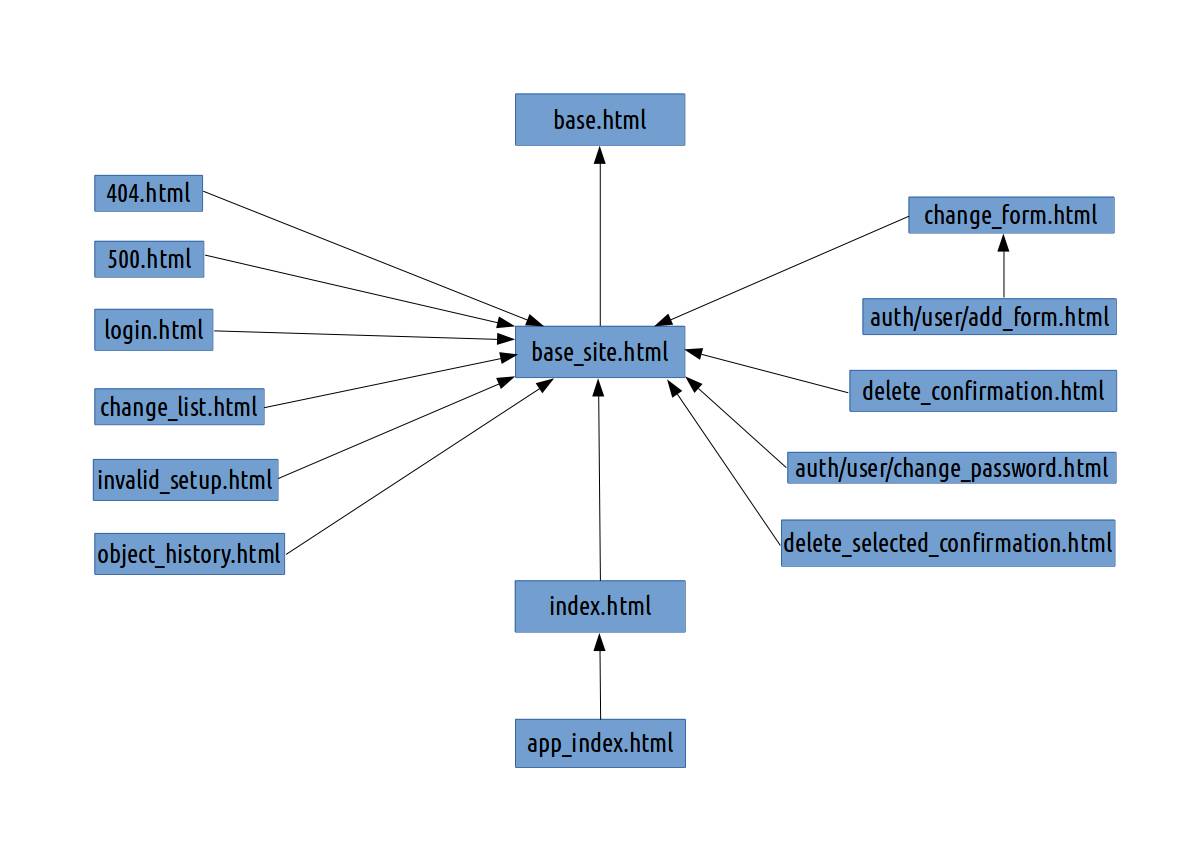Django admin template structure
Posted on Sun 16 October 2016 in Django
As you all (probably) know, Django is a magnificent Web framework to build the website of your dreams. There is a plethora of tutorials, how-to's, getting-started, django-for-dummies out there in the internet-wild. I am not going to show you the Django basics (models, views, templates or forms to name a few). I just want to share with you the template inheritance of the incredible Django admin contribution package.
At this time of writing, I am dreaming of a much more appealing admin interface which is based on the super-fancy AdminLTE template (there is a free version you can download, under the MIT License -- more about licences here). But in order to adopt the new-dreamed template in my own project I must understand the template inheritance workflow of the built-in Django admin app.
I know there is a package, already out there (django-adminlte-templates), that offer you the capability of using this admin template but I wanted to deeply understand how the Django admin template system is assembled and working so flawlessly. Lets get to work:
The core ones
In this section we will describe briefly, the core HTML templates where the rest inherit from. If you do not have Django installed (!) or you're bored enough right now to navigate to the actual path where these templates are stored in your machine, here is Django's admin github source for the templates (you're one click away!).
As you can see there are two folders admin and registration. In the rest of this article we will assume that we are working under the admin directory, unless stated otherwise where we will be under the registration directory.
base.html
As Ane Brun says in her song One:
It all starts somewhere, it all starts with one
The root of the Django admin templates is this file and is located inside the Django folder that you installed via your preferred method.
Assuming that:
- you are using
virtualenv - you are using Linux and
- your
.virtualenvsfolder is inside your$HOMEdirectory (note the.dot in front - indicates a hidden file. PressCtrl+Hto view hidden files)
then you will find this file following this path: $HOME/.virtualenvs/<your_virtual_env_name>/lib/python<your_version_of_python>/site-packages/django/contrib/admin/templates/admin
Easy eh?
Inside the admin folder you will find all the templates Django admin uses, to present itself. Nothing inherits directly from this file (in other words, there is no template which has this line at the top: {% extends "admin/base.html" %}) except from the base_site.html file.
base_site.html
This is the only file that extends the one file (the root, the base.html file). I believe, until now you are following along.
Every other template file extends this one (see the graph below for a better understanding). What? An exception? Oh, yes! Let me rephrase it:
Every other template file extends this one except from the app_index.html file which extends index.html which in turn extends base_site.html which (finally) extends base.html. This would be the longest chain of extends you will find in the Django admin templates.
index.html
This file is just used as a base template for the app_index.html file. No other file extends index.html. Only the app_index.html extends index.html.
Rest of the templates
Every other single template (apart from the ones mentioned above) either extends the base_site.html or act as standalone ready to be included somewhere (for example actions.html).
URL-Template file relationship
In this section we will see which template file is actually called under a particular admin URL. We are assuming that inside your URLconf file (also known as urls.py) the string admin is the one that you have chosen to visit the admin website. For example, if your site is mywebsite.com and this line is in your urlpatterns variable under urls.py: url(r'^admin/', include(admin.site.urls)), then you should visit the magnificent admin website at mywebsite.com/admin/.
- URL:
yourwebsite.com/<app_label>/<model_name>/, Template:change_list.html- Inside the template
change_list.htmlthe following templates are included:change_list_results.html,actions.htmlandpagination.html
- Inside the template
| URL (yourwebsite.com/admin/...) | Template | Comments |
|---|---|---|
'' |
index.html |
The admin home page |
<app_label>/ |
app_index.html |
You have clicked on the name of the app (not model) |
<app_label>/<model_name>/ |
change_list.html¹ |
You have clicked on the name of a model |
<app_label>/<model_name>/<pk>/change/ <app_label>/<model_name>/add/ |
change_form.html² |
You have clicked on an object to change it |
<app_label>/<model_name>/<pk>/history/ |
object_history.html |
You have clicked on the HISTORY button to see the object's history |
<app_label>/<model_name>/ |
delete_confirmation.html³ |
You have checked one object, selected Delete selected |
<app_label>/<model_name>/ |
delete_selected_confirmation.html³ |
You have checked multiple objects, selected Delete selected |
login/ |
login.html |
You requested to login |
password_change/ |
registration/password_change_form.html |
You requested to change your password |
logout/ |
registration/logged_out.html |
You requested to logged out |
¹ Inside the template change_list.html these templates are used:
change_list_results.html(to show the objects of this model - entries in the database, if you like)actions.html(to show the actionsdivwhich contains the default actionDeleteand any other of your own)pagination.html(for the pagination across your objects)date_hierarchy.html(only if thedate_hierarchyis used)filter.html(only if thelist_filteris used)search_form.html(only if thesearch_fieldsis used)
² Inside the template change_form.html these templates are used:
edit_inline/stacked.htmlandedit_inline/tabular.html(if theStackedInlineorTabularInlineis used)related_widget_wrapper.html(again, if an inline is used)includes/fieldset.html(if thefieldsetsor/and an inline is used)submit_line.html(in order to show the bottom - or top -divof the Delete, Save and add another`, Save and continue editing and Save buttons)prepopulated_fields_js.html(if theprepopulated_fieldsis used)
³ Inside the templates delete_confirmation.html and delete_selected_confirmation.html the includes/object_delete_summary.htmltemplate is used.
